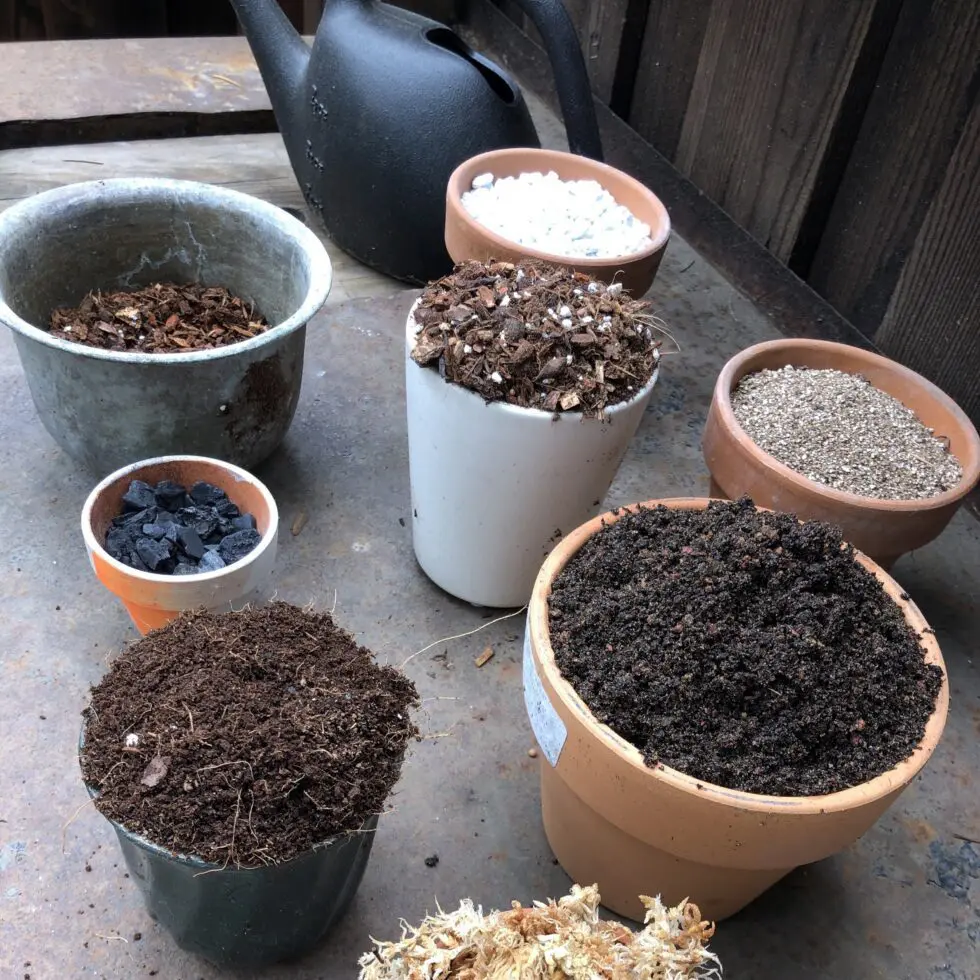Even with plants that you intend to keep in the same pot over time, you need to change the mix regularly so that the plant grows well and thrives. This is because elements of your potting mix break down over time, and the mix will lose its draining qualities and air spaces to hold oxygen.
Mixes for outdoors
You will need a mix that’s very porous and allows water to drain well. It should have enough organic matter to counteract alkaline water as it breaks down. You’ll know plants like it if they grow strong, healthy roots. You should experiment with various mixes, and find a mix that works perfectly for you.
Some commercial mixes contain too much sand, which is too heavy for the fine roots of begonias and others contain sawdust, which binds up the nitrogen in the potting mix so that your fertilizer does not work properly. Some stay either too wet or too dry, even when mixed with other amendments such as perlite or oak leaf mold.
One important note is whatever mix you use, should not contain garden soil. Instead, use mixes that are soilless. This means they are composed of organic components but do not actually contain soil that may carry soil-borne pests and diseases. Peat-based soil mixes are available, but present sustainability issues, as peat is a nonrenewable resource. Also, if composed mainly of peat, the mix can be hard to rewet if it dries out completely, as they compact and become resistant to rewetting in the center of the root ball. Many growers are turning to coco coir-based mixes which retain moisture while providing excellent drainage with less compacting. Other sustainable alternatives to peat and peat moss are leaf mold, compost, wood shavings, fir bark, and pine needles to name a few. As with anything, quality in processing is important for good plant hygiene.
If you buy a plant that is planted in a mix very different from the one you use, remove as much of the original potting mix as possible and repot in your own mix. A reason is that if the old mix is peat-heavy, it will not be good for your Begonia over time. As discussed above, peat can dry out so badly that it resists rewetting; plants in these kinds of soils can be watered daily without the core of the pot ever receiving any moisture. For this reason, plants will suffer mysteriously, if you do not keep an eye on unamended peat mixes.
Here is one mix that may work for outdoor begonias:
- 1 part coco coir based planter mix
- 1 part leaf mold (preferably oak)
- 1 part small (1/8 in to 1/4 in) size orchid bark
- 1 part #2 or larger perlite
Some growers use prepackaged mixes and combinations based on Sunshine™, Fafard™, Miracle-Gro™, Supersoil™, Pro-Mix™, Ocean Forest™, and other brand mixes with excellent results.
Mixes for indoors
For plants grown indoors, you should use a soilless mix. Most prepackaged mixes are fine for begonias grown indoors, although you may need to add perlite. You should not add ingredients such as oak leaf mold to mixes for indoor growing. It is important that mixes for indoors hold moisture and nutrients, and give the roots something to hold on to.
Here is one mix that may work for indoor begonias:
- 1 part coco coir based planter mix
- 1 part small (1/8 in to 1/4 in) size orchid bark
- 1 part #2 or larger perlite
Mixes for Terrariums and other enclosed containers
Begonias grown in enclosed containers have other needs for their planting mediums. The Buxton branch has an excellent article on the growing mix for terrariums. https://www.buxtonbegonia.org/how-to-make-a-terrarium.html. Another terrarium growing medium is frequently referred to as “dirty sphagnum” where the Begonia grows atop a slightly mounded clump of) good quality long-fiber sphagnum mixed with a light dusting of perlite; this may be done with or without a base layer of gravel or potting mix. Other options include a preferred growing mix, such as Pro-Mix or Ocean Forest
Other growing mediums
As cultural methods for conservation of species ex situ expand, many growers have forayed into media such as akadama, expanded clay pellets, or rock or bark mounts.
For those without access to a greenhouse, some have turned to indoor grow tents or rainforest vivarium-type terrariums with misting systems. One grower has famously developed a method of semi-hydroponic growing in mophead materials!
Your ideal methods and growing mediums will be dictated by the climate and existing conditions of your growing location, whether inside or outside your home or in a specialized structure like a greenhouse or lathe house. Consulting other Begonia growers in your area via your closest ABS Branch will give you a good place to start in determining a good mix for your begonias.
Edited and expanded from an original article By Brad Thompson, Potting, Potting Mixes & Repotting


